Comprehensive Report on Fair Value Accounting in Financial Reporting
VerifiedAdded on 2021/01/01
|9
|1781
|71
Report
AI Summary
This report provides a comprehensive overview of fair value accounting within the context of financial reporting. It begins by defining fair value accounting and its role in financial transactions. The main body delves into the pros and cons of fair value accounting in a globalized economy, highlighting aspects like accurate valuation, timely information, and potential for manipulation. The report then explores the three-tier process of accounting, also known as 360-degree fraud management, detailing the roles of mission control, customer journey, and knowledge position. Finally, it examines the qualitative characteristics of financial information, such as relevance, understandability, and faithful representation, in the context of fair value methods. The report concludes by summarizing the key findings and referencing relevant literature on the subject. This report is a valuable resource for students seeking to understand the intricacies of fair value accounting.
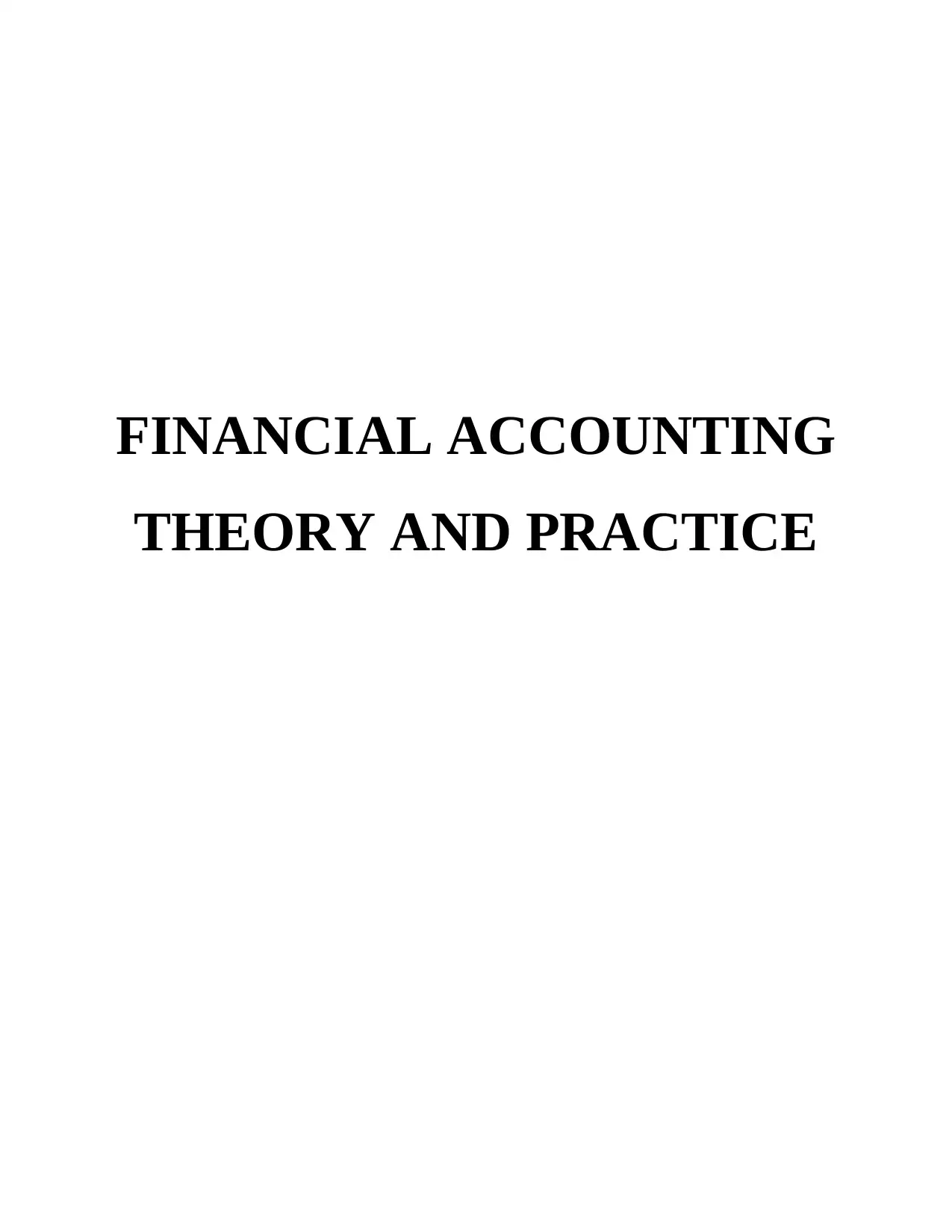
FINANCIAL ACCOUNTING
THEORY AND PRACTICE
THEORY AND PRACTICE
Paraphrase This Document
Need a fresh take? Get an instant paraphrase of this document with our AI Paraphraser
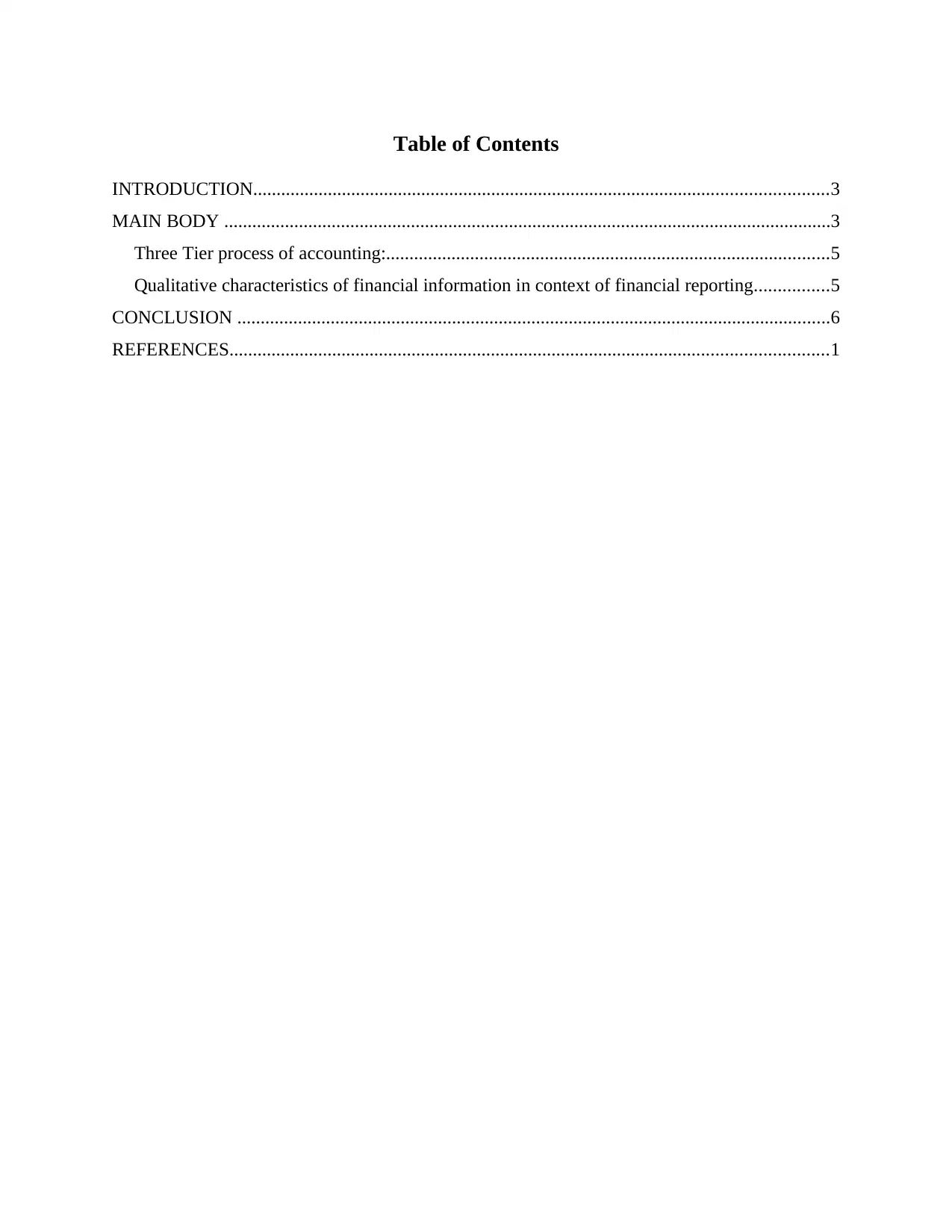
Table of Contents
INTRODUCTION...........................................................................................................................3
MAIN BODY ..................................................................................................................................3
Three Tier process of accounting:...............................................................................................5
Qualitative characteristics of financial information in context of financial reporting................5
CONCLUSION ...............................................................................................................................6
REFERENCES................................................................................................................................1
INTRODUCTION...........................................................................................................................3
MAIN BODY ..................................................................................................................................3
Three Tier process of accounting:...............................................................................................5
Qualitative characteristics of financial information in context of financial reporting................5
CONCLUSION ...............................................................................................................................6
REFERENCES................................................................................................................................1
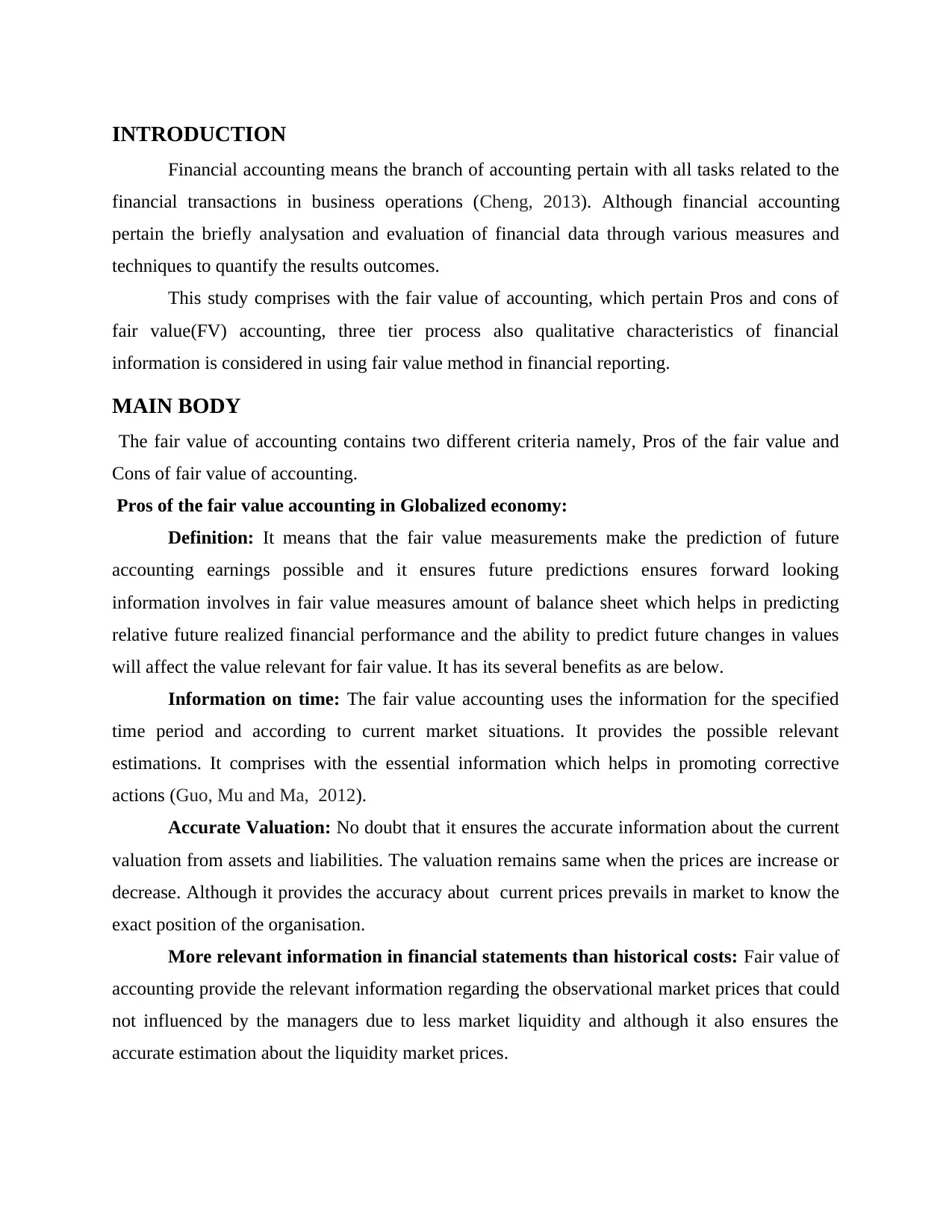
INTRODUCTION
Financial accounting means the branch of accounting pertain with all tasks related to the
financial transactions in business operations (Cheng, 2013). Although financial accounting
pertain the briefly analysation and evaluation of financial data through various measures and
techniques to quantify the results outcomes.
This study comprises with the fair value of accounting, which pertain Pros and cons of
fair value(FV) accounting, three tier process also qualitative characteristics of financial
information is considered in using fair value method in financial reporting.
MAIN BODY
The fair value of accounting contains two different criteria namely, Pros of the fair value and
Cons of fair value of accounting.
Pros of the fair value accounting in Globalized economy:
Definition: It means that the fair value measurements make the prediction of future
accounting earnings possible and it ensures future predictions ensures forward looking
information involves in fair value measures amount of balance sheet which helps in predicting
relative future realized financial performance and the ability to predict future changes in values
will affect the value relevant for fair value. It has its several benefits as are below.
Information on time: The fair value accounting uses the information for the specified
time period and according to current market situations. It provides the possible relevant
estimations. It comprises with the essential information which helps in promoting corrective
actions (Guo, Mu and Ma, 2012).
Accurate Valuation: No doubt that it ensures the accurate information about the current
valuation from assets and liabilities. The valuation remains same when the prices are increase or
decrease. Although it provides the accuracy about current prices prevails in market to know the
exact position of the organisation.
More relevant information in financial statements than historical costs: Fair value of
accounting provide the relevant information regarding the observational market prices that could
not influenced by the managers due to less market liquidity and although it also ensures the
accurate estimation about the liquidity market prices.
Financial accounting means the branch of accounting pertain with all tasks related to the
financial transactions in business operations (Cheng, 2013). Although financial accounting
pertain the briefly analysation and evaluation of financial data through various measures and
techniques to quantify the results outcomes.
This study comprises with the fair value of accounting, which pertain Pros and cons of
fair value(FV) accounting, three tier process also qualitative characteristics of financial
information is considered in using fair value method in financial reporting.
MAIN BODY
The fair value of accounting contains two different criteria namely, Pros of the fair value and
Cons of fair value of accounting.
Pros of the fair value accounting in Globalized economy:
Definition: It means that the fair value measurements make the prediction of future
accounting earnings possible and it ensures future predictions ensures forward looking
information involves in fair value measures amount of balance sheet which helps in predicting
relative future realized financial performance and the ability to predict future changes in values
will affect the value relevant for fair value. It has its several benefits as are below.
Information on time: The fair value accounting uses the information for the specified
time period and according to current market situations. It provides the possible relevant
estimations. It comprises with the essential information which helps in promoting corrective
actions (Guo, Mu and Ma, 2012).
Accurate Valuation: No doubt that it ensures the accurate information about the current
valuation from assets and liabilities. The valuation remains same when the prices are increase or
decrease. Although it provides the accuracy about current prices prevails in market to know the
exact position of the organisation.
More relevant information in financial statements than historical costs: Fair value of
accounting provide the relevant information regarding the observational market prices that could
not influenced by the managers due to less market liquidity and although it also ensures the
accurate estimation about the liquidity market prices.
⊘ This is a preview!⊘
Do you want full access?
Subscribe today to unlock all pages.

Trusted by 1+ million students worldwide
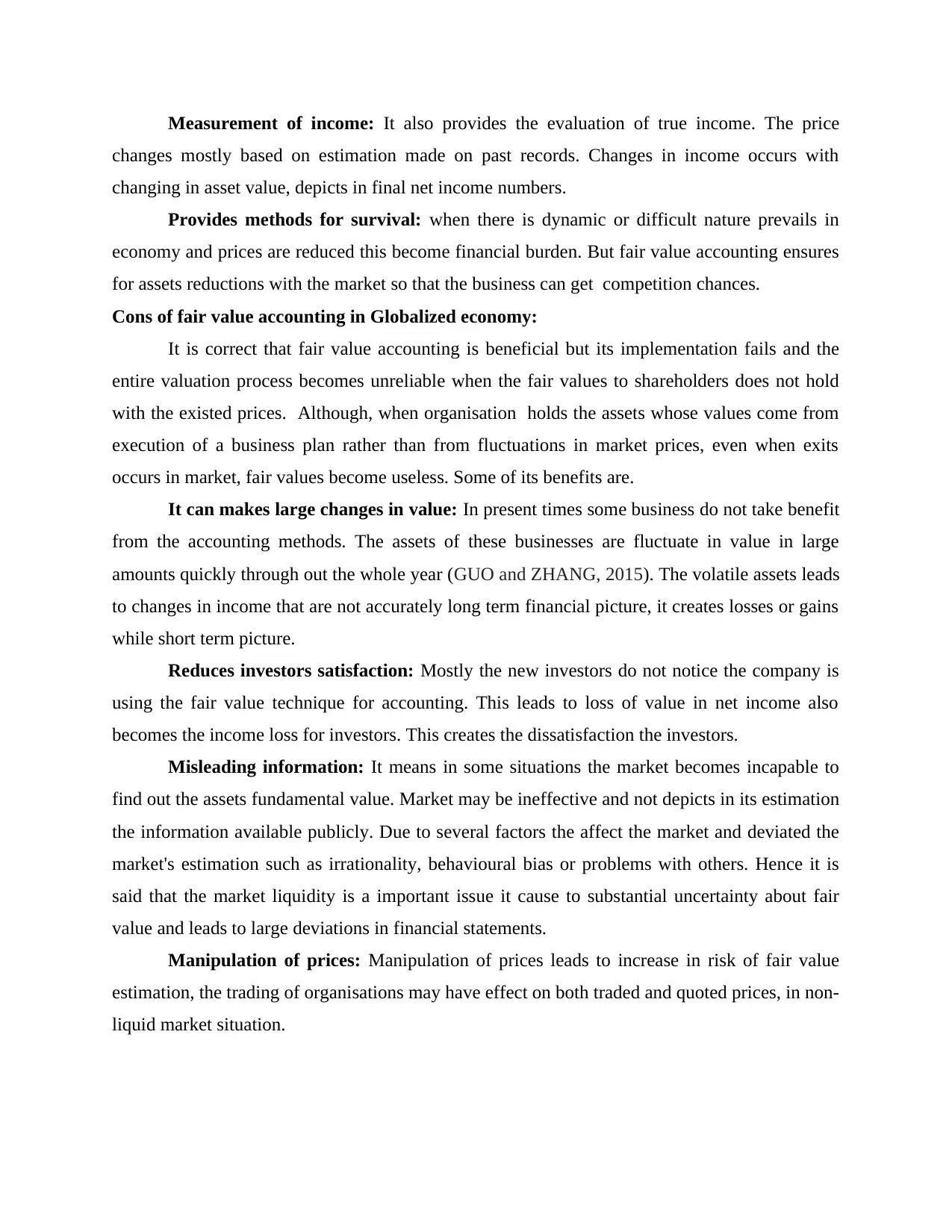
Measurement of income: It also provides the evaluation of true income. The price
changes mostly based on estimation made on past records. Changes in income occurs with
changing in asset value, depicts in final net income numbers.
Provides methods for survival: when there is dynamic or difficult nature prevails in
economy and prices are reduced this become financial burden. But fair value accounting ensures
for assets reductions with the market so that the business can get competition chances.
Cons of fair value accounting in Globalized economy:
It is correct that fair value accounting is beneficial but its implementation fails and the
entire valuation process becomes unreliable when the fair values to shareholders does not hold
with the existed prices. Although, when organisation holds the assets whose values come from
execution of a business plan rather than from fluctuations in market prices, even when exits
occurs in market, fair values become useless. Some of its benefits are.
It can makes large changes in value: In present times some business do not take benefit
from the accounting methods. The assets of these businesses are fluctuate in value in large
amounts quickly through out the whole year (GUO and ZHANG, 2015). The volatile assets leads
to changes in income that are not accurately long term financial picture, it creates losses or gains
while short term picture.
Reduces investors satisfaction: Mostly the new investors do not notice the company is
using the fair value technique for accounting. This leads to loss of value in net income also
becomes the income loss for investors. This creates the dissatisfaction the investors.
Misleading information: It means in some situations the market becomes incapable to
find out the assets fundamental value. Market may be ineffective and not depicts in its estimation
the information available publicly. Due to several factors the affect the market and deviated the
market's estimation such as irrationality, behavioural bias or problems with others. Hence it is
said that the market liquidity is a important issue it cause to substantial uncertainty about fair
value and leads to large deviations in financial statements.
Manipulation of prices: Manipulation of prices leads to increase in risk of fair value
estimation, the trading of organisations may have effect on both traded and quoted prices, in non-
liquid market situation.
changes mostly based on estimation made on past records. Changes in income occurs with
changing in asset value, depicts in final net income numbers.
Provides methods for survival: when there is dynamic or difficult nature prevails in
economy and prices are reduced this become financial burden. But fair value accounting ensures
for assets reductions with the market so that the business can get competition chances.
Cons of fair value accounting in Globalized economy:
It is correct that fair value accounting is beneficial but its implementation fails and the
entire valuation process becomes unreliable when the fair values to shareholders does not hold
with the existed prices. Although, when organisation holds the assets whose values come from
execution of a business plan rather than from fluctuations in market prices, even when exits
occurs in market, fair values become useless. Some of its benefits are.
It can makes large changes in value: In present times some business do not take benefit
from the accounting methods. The assets of these businesses are fluctuate in value in large
amounts quickly through out the whole year (GUO and ZHANG, 2015). The volatile assets leads
to changes in income that are not accurately long term financial picture, it creates losses or gains
while short term picture.
Reduces investors satisfaction: Mostly the new investors do not notice the company is
using the fair value technique for accounting. This leads to loss of value in net income also
becomes the income loss for investors. This creates the dissatisfaction the investors.
Misleading information: It means in some situations the market becomes incapable to
find out the assets fundamental value. Market may be ineffective and not depicts in its estimation
the information available publicly. Due to several factors the affect the market and deviated the
market's estimation such as irrationality, behavioural bias or problems with others. Hence it is
said that the market liquidity is a important issue it cause to substantial uncertainty about fair
value and leads to large deviations in financial statements.
Manipulation of prices: Manipulation of prices leads to increase in risk of fair value
estimation, the trading of organisations may have effect on both traded and quoted prices, in non-
liquid market situation.
Paraphrase This Document
Need a fresh take? Get an instant paraphrase of this document with our AI Paraphraser

Absence of historical perspective: Accounting is important to measure what happened
historically for accuracy in tracking results. Although the assets reduces net profit and has a
down year. It can formally lower the successes that a business may achieved.
Three Tier process of accounting:
The Three tyre approach called 360 degrees fraud management which pertain different
set of tools for enabling organisations to avoid the wicked problem of fraud with customers. To
meet customers satisfaction and expectations in a secure manner, organisation make the fraud
management as separate design,k for continuous development and management of their customer
journey.
Tier 1 Mission control: It is crucial to explain all responsibilities and roles that are
associated with the regular governance as possible to avoid the irrelevant costs and promote
organisational agility (Hai-xia, Zhi and Xue-ran, 2012). Moreover, proper analysation ensures
the organisation to take corrective actions when fraud pattern emerges. Although it will also
helps the organisation to identifying consolidate opportunities for fraud measures, which is
important to quantifying the new solutions and implementing the available solutions.
Tier 2 Customer journey: The customer journey is the main part of the approach,
because it is regarding to secure the interest of the customer and what the organisation is all
about. By providing convenient, secure, cost effective services to customers it help in building
the goodwill and organisational growth. In order to secure the customers interest it is essential to
provide fraud less system of services and payment.
Tier 3 Knowledge position: Last tier is knowledge position of the organisation which is
essential while making informed decisions and corrective actions. In present times, many
organisations are exchanging fraud intelligence, both quid-pro-quo and in commercial manner.
The intelligence ranges from stolen credentials or retrieved from under ground forums to
customer's suspicious IP addresses (Lu, 2012). But as in case of high profile frauds or breach of
securities customers are much more aware of potential risks.
Qualitative characteristics of financial information in context of financial reporting
The financial reporting comprises with the reporting of high quality financial reporting
information concerning economic entities, must be financial in nature , useful for economic
decisions making. High quality financial reporting is essential, it influence the investors decision
historically for accuracy in tracking results. Although the assets reduces net profit and has a
down year. It can formally lower the successes that a business may achieved.
Three Tier process of accounting:
The Three tyre approach called 360 degrees fraud management which pertain different
set of tools for enabling organisations to avoid the wicked problem of fraud with customers. To
meet customers satisfaction and expectations in a secure manner, organisation make the fraud
management as separate design,k for continuous development and management of their customer
journey.
Tier 1 Mission control: It is crucial to explain all responsibilities and roles that are
associated with the regular governance as possible to avoid the irrelevant costs and promote
organisational agility (Hai-xia, Zhi and Xue-ran, 2012). Moreover, proper analysation ensures
the organisation to take corrective actions when fraud pattern emerges. Although it will also
helps the organisation to identifying consolidate opportunities for fraud measures, which is
important to quantifying the new solutions and implementing the available solutions.
Tier 2 Customer journey: The customer journey is the main part of the approach,
because it is regarding to secure the interest of the customer and what the organisation is all
about. By providing convenient, secure, cost effective services to customers it help in building
the goodwill and organisational growth. In order to secure the customers interest it is essential to
provide fraud less system of services and payment.
Tier 3 Knowledge position: Last tier is knowledge position of the organisation which is
essential while making informed decisions and corrective actions. In present times, many
organisations are exchanging fraud intelligence, both quid-pro-quo and in commercial manner.
The intelligence ranges from stolen credentials or retrieved from under ground forums to
customer's suspicious IP addresses (Lu, 2012). But as in case of high profile frauds or breach of
securities customers are much more aware of potential risks.
Qualitative characteristics of financial information in context of financial reporting
The financial reporting comprises with the reporting of high quality financial reporting
information concerning economic entities, must be financial in nature , useful for economic
decisions making. High quality financial reporting is essential, it influence the investors decision

regarding investments and helps the stakeholders to make decisions for business operations and
for future growth.
Some qualitative characteristics of financial information in context of FV method in
financial reporting.
Relevance: It means the ability of making a differences in decision making by users in
their own capacity as capital providers or investors. Relevance is optimised by using four items
refers to predictive and confirmatory value. The organisation focuses on earning quality instead
of reporting quality, although the earning quality is based on High quality reporting. Four items
of relevance are , Predictive value as the ability of past earnings to predict future earnings,
Measures to what extent of annual reports discloses information in terms of opportunities and
risks, company's use of fair values etc.
Understandability: The qualitative characteristics involves the understandability, the
financial information is classified, characterized and presented clearly and concisely.
Understandability means the information is recorded in such a systematic way that is easily
understandable to its users, internal and external users of it.
Faithful representation: It is clear that statements must be clear and faithful that
represent the actual financial position of company for an accounting year. This means that report
must be clear and and do not carry any false information, these report must be prepared by using
Generally Accepted accounting principle (Yan, 2012). Auditor with these financial statements
figure out the actual financial position of company that further help investor and other
stakeholder to review financial strength of and may invest. It is considers that more accurate
financial statements will be give more reliable picture of company that help them to attract large
number of stockholder in order to attain more dividend.
CONCLUSION
The study pertains the concept of fair value accounting in business environment and it is
evolving over past years. Also playing important role with regards to accounting standards.
Changes in business economy driven by the information revolution had accelerated the inclusion
of the fair value concept and measurement into financial reporting.
for future growth.
Some qualitative characteristics of financial information in context of FV method in
financial reporting.
Relevance: It means the ability of making a differences in decision making by users in
their own capacity as capital providers or investors. Relevance is optimised by using four items
refers to predictive and confirmatory value. The organisation focuses on earning quality instead
of reporting quality, although the earning quality is based on High quality reporting. Four items
of relevance are , Predictive value as the ability of past earnings to predict future earnings,
Measures to what extent of annual reports discloses information in terms of opportunities and
risks, company's use of fair values etc.
Understandability: The qualitative characteristics involves the understandability, the
financial information is classified, characterized and presented clearly and concisely.
Understandability means the information is recorded in such a systematic way that is easily
understandable to its users, internal and external users of it.
Faithful representation: It is clear that statements must be clear and faithful that
represent the actual financial position of company for an accounting year. This means that report
must be clear and and do not carry any false information, these report must be prepared by using
Generally Accepted accounting principle (Yan, 2012). Auditor with these financial statements
figure out the actual financial position of company that further help investor and other
stakeholder to review financial strength of and may invest. It is considers that more accurate
financial statements will be give more reliable picture of company that help them to attract large
number of stockholder in order to attain more dividend.
CONCLUSION
The study pertains the concept of fair value accounting in business environment and it is
evolving over past years. Also playing important role with regards to accounting standards.
Changes in business economy driven by the information revolution had accelerated the inclusion
of the fair value concept and measurement into financial reporting.
⊘ This is a preview!⊘
Do you want full access?
Subscribe today to unlock all pages.

Trusted by 1+ million students worldwide

Paraphrase This Document
Need a fresh take? Get an instant paraphrase of this document with our AI Paraphraser
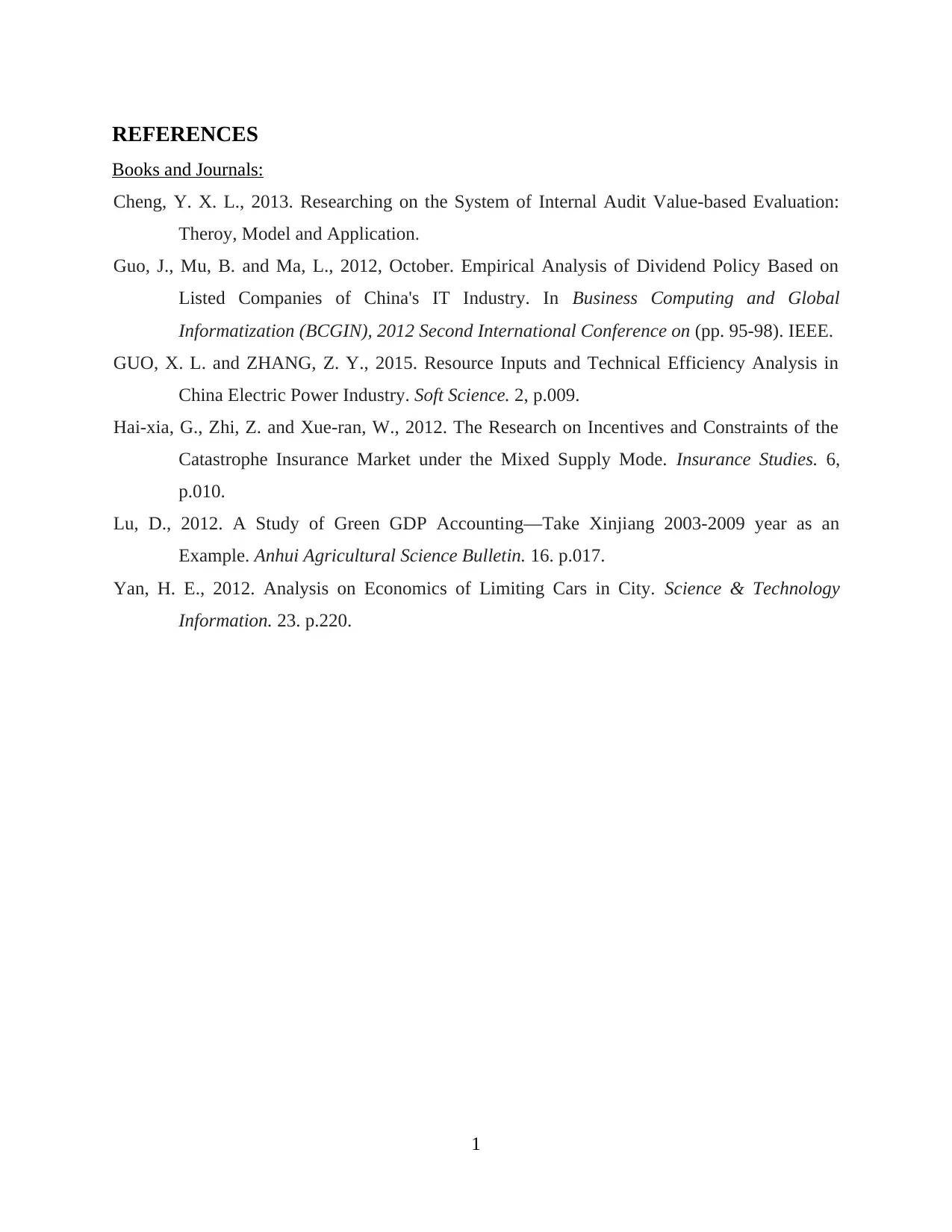
REFERENCES
Books and Journals:
Cheng, Y. X. L., 2013. Researching on the System of Internal Audit Value-based Evaluation:
Theroy, Model and Application.
Guo, J., Mu, B. and Ma, L., 2012, October. Empirical Analysis of Dividend Policy Based on
Listed Companies of China's IT Industry. In Business Computing and Global
Informatization (BCGIN), 2012 Second International Conference on (pp. 95-98). IEEE.
GUO, X. L. and ZHANG, Z. Y., 2015. Resource Inputs and Technical Efficiency Analysis in
China Electric Power Industry. Soft Science. 2, p.009.
Hai-xia, G., Zhi, Z. and Xue-ran, W., 2012. The Research on Incentives and Constraints of the
Catastrophe Insurance Market under the Mixed Supply Mode. Insurance Studies. 6,
p.010.
Lu, D., 2012. A Study of Green GDP Accounting—Take Xinjiang 2003-2009 year as an
Example. Anhui Agricultural Science Bulletin. 16. p.017.
Yan, H. E., 2012. Analysis on Economics of Limiting Cars in City. Science & Technology
Information. 23. p.220.
1
Books and Journals:
Cheng, Y. X. L., 2013. Researching on the System of Internal Audit Value-based Evaluation:
Theroy, Model and Application.
Guo, J., Mu, B. and Ma, L., 2012, October. Empirical Analysis of Dividend Policy Based on
Listed Companies of China's IT Industry. In Business Computing and Global
Informatization (BCGIN), 2012 Second International Conference on (pp. 95-98). IEEE.
GUO, X. L. and ZHANG, Z. Y., 2015. Resource Inputs and Technical Efficiency Analysis in
China Electric Power Industry. Soft Science. 2, p.009.
Hai-xia, G., Zhi, Z. and Xue-ran, W., 2012. The Research on Incentives and Constraints of the
Catastrophe Insurance Market under the Mixed Supply Mode. Insurance Studies. 6,
p.010.
Lu, D., 2012. A Study of Green GDP Accounting—Take Xinjiang 2003-2009 year as an
Example. Anhui Agricultural Science Bulletin. 16. p.017.
Yan, H. E., 2012. Analysis on Economics of Limiting Cars in City. Science & Technology
Information. 23. p.220.
1

1
⊘ This is a preview!⊘
Do you want full access?
Subscribe today to unlock all pages.

Trusted by 1+ million students worldwide
1 out of 9
Related Documents
Your All-in-One AI-Powered Toolkit for Academic Success.
+13062052269
info@desklib.com
Available 24*7 on WhatsApp / Email
![[object Object]](/_next/static/media/star-bottom.7253800d.svg)
Unlock your academic potential
Copyright © 2020–2025 A2Z Services. All Rights Reserved. Developed and managed by ZUCOL.





